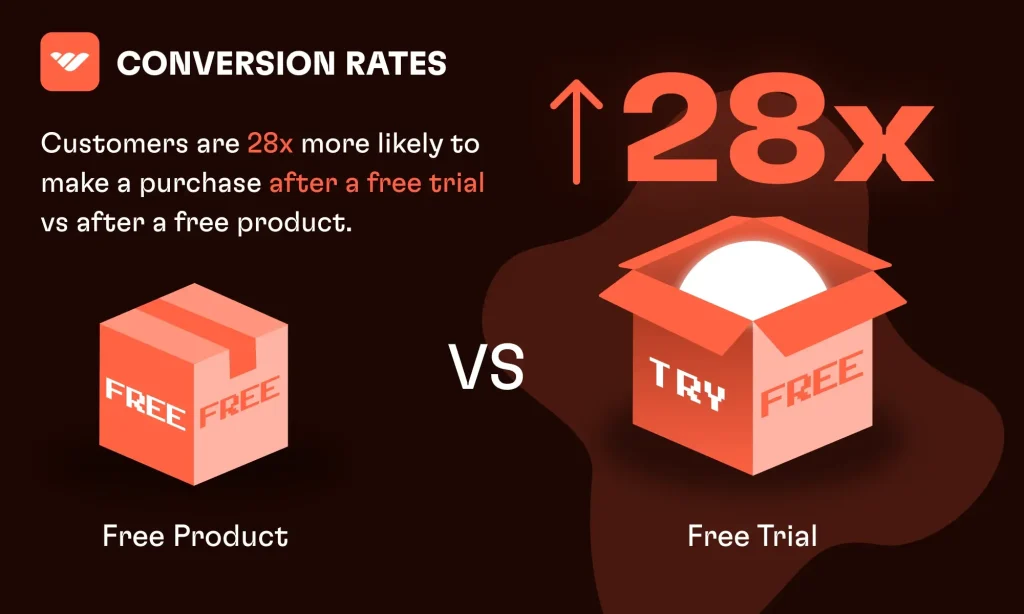
Free trials have become a powerful tool for e-commerce sellers, with over a quarter of them embracing this strategy in 2023. These trials give potential customers a taste of a product without any cost, hoping they will eventually pay to continue using it. Major players like Spotify, Hulu, and Amazon Prime have long used free trials to draw in new users. Now, more businesses are realizing that a well-timed free trial can dramatically boost their conversion rates.
Key Insights from the Study
1. The 30-Day Edge
Our latest research shows that a 30-day free trial reigns supreme in driving customer acquisition and conversion rates. This duration outperforms shorter trials of 3, 7, and 14 days by a significant margin.
2. Free Trials Beat Free Products
Simply giving away a product doesn’t cut it. Less than 2% of users who receive a free product end up paying for it. In contrast, a well-structured free trial has a much higher success rate.
3. Time Equals Value
The longer the free trial, the more value users perceive. A 30-day period allows users to fully appreciate the benefits of a product, making them more likely to commit to a purchase.

Why Free Trials Work
Offering a free trial isn’t just a generous gesture; it’s a strategic move. Here’s why:
Boosting Sales
Free trials can turn curious browsers into loyal buyers. When users experience a product’s full benefits for free, they’re more inclined to make a purchase.
Psychological Reciprocity
When people receive something for free, they often feel compelled to give back. This psychological trigger can significantly increase conversion rates.
Cost-Effective Marketing
For digital products, free trials are a marketing goldmine. Unlike physical goods, there’s no substantial cost involved, especially when platforms like Whop cover hosting costs only after a sale.
The Crucial Role of Conversion Rates
Conversion rates are the heartbeat of any free trial strategy. Here’s why monitoring these rates is essential:
Avoiding Freebie Seekers
Some users might exploit the system, signing up for multiple trials with different email addresses. A high conversion rate indicates that your strategy attracts genuine, paying customers.
Measuring Success
A higher conversion rate means your free trial is working. It shows that users find value in your product and are willing to pay for continued access.
The Data Speaks: 30 Days is Optimal
We analyzed various free trial lengths and their impact on user conversion. Here’s the breakdown:
- 3-Day Trial: Converts at 35%, but only 2% of users opt for it.
- 7-Day Trial: Attracts 22% of users but converts only 20%.
- 14-Day Trial: Chosen by 9% of users, with a 15% conversion rate.
- 30-Day Trial: The clear winner, engaging 32% of users and converting 56%.
The 30-Day Advantage
Businesses might hesitate to offer a 30-day trial, fearing they’ll lose out by giving away a month of free access. However, the extended period lets users deeply integrate the product into their routines. The more they use it, the more they rely on it, making them more likely to become paying customers.
Making the Switch with Whop
The evidence is clear: a 30-day free trial is the most effective strategy for attracting and converting customers. Instead of offering free products, consider switching to a 30-day trial. This approach makes users 28 times more likely to purchase than those who receive a free product.
In conclusion, if you’re looking to boost your business, a 30-day free trial could be your ticket to higher conversion rates and increased sales. It’s not just about giving something away—it’s about investing in a strategy that pays off.
Whop will help your company improve conversions.
